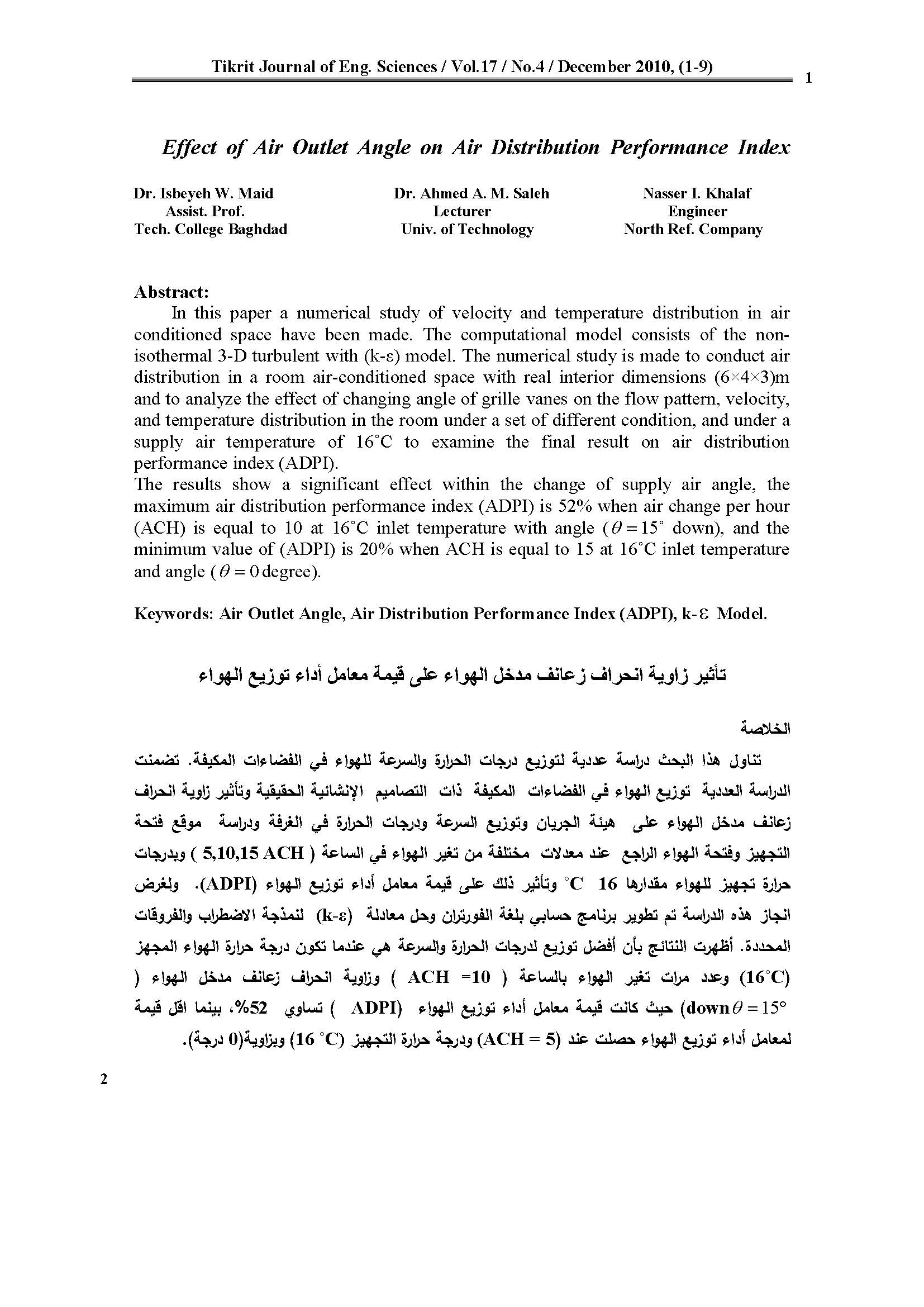Effect of Air Outlet Angle on Air Distribution Performance Index
محتوى المقالة الرئيسي
الملخص
In this paper a numerical study of velocity and temperature distribution in air conditioned space have been made. The computational model consists of the non-isothermal 3-D turbulent with (k-ε) model. The numerical study is made to conduct air distribution in a room air-conditioned space with real interior dimensions (6×4×3)m and to analyze the effect of changing angle of grille vanes on the flow pattern, velocity, and temperature distribution in the room under a set of different condition, and under a supply air temperature of 16˚C to examine the final result on air distribution performance index (ADPI). The results show a significant effect within the change of supply air angle, the maximum air distribution performance index (ADPI) is 52% when air change per hour (ACH) is equal to 10 at 16˚C inlet temperature with angle (15˚ down), and the minimum value of (ADPI) is 20% when ACH is equal to 15 at 16˚C inlet temperature and angle (degree).
تفاصيل المقالة
القسم

هذا العمل مرخص بموجب Creative Commons Attribution 4.0 International License.
THIS IS AN OPEN ACCESS ARTICLE UNDER THE CC BY LICENSE http://creativecommons.org/licenses/by/4.0/
المراجع
Jalal M. Jalil, Journal of Engineering, “Three Dimensional Transient, Turbulent, Buoyant Air Distribution inside room”, University of Al- Mustansiria, Volume 6-NO.5, 2002.
Hanaa Muhsen Mohammed Ali “Numerical Study of Isothermal and Non- Isothermal flow in Ventilated Rooms” M.Sc Thesis, University of TechnologyBaghdad, 2003.
H. B. Awbi, “Application of computational fluid dynamics in room ventilation”, Building and Environment, Vol.24, pp.73-84, 1989.
Haghighat, F, Z. Jiang and J. C. Y Wang, “Natural Convection and Air Flow Pattern in a Partitioned Room with Turbulent Flow”, ASHRAE Journal, pp. 600-610,1989.
Michael Ramey, J. Spitler, “Application of Computational Fluid Dynamics to Indoor Room AirFlow”, M.sc. Theses, Okiahoma Christian University, 1994.
Florin Baltaretu, “Numerical prediction of air flow pattern in a ventilated room”, Analele University, PP.11-16, 2001
Tom Wilson, and Rana Belshe, “COMF1 Principle of thermal comfort”, Cleveland, Ohio, 2007.
Lilley, D. G., “Three Dimensional Flow Prediction for Industrial Mixing”, ASME International Computers In Engineering Conference, San Francisco, CA, 1988.
Ahmed A. M. Saleh, “Experimental and Numerical Study on the Effect of Velocity and Temperature Distributions in a Large Space”, PhD Thesis, University of Technology Baghdad, 2005.
F. H. Harlow, and J. E.Welch, (1965), Numerical Calculation of Time Dependent Viscose Incompressible flow of Fluid with Free Surface, the physical of fluid, vol.8, No.13, pp. (2182-2189).
Hirt, C. W. and J. L. Cook, (1972), Calculation Three Dimensional Flows Around Structures and Over Rough Terrain, Journal of Computational Physics, Vol. 10, PP. 324-340.





